Publications
Highlights
A full list of publications is below. All papers are available on arXiv.
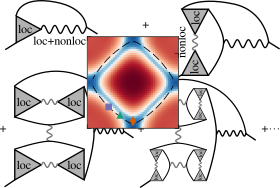
What’s the microscopic mechanism for the strong-coupling pseudogap and how to solve it? We develop the finite-difference parquet scheme to build a diagrammatic expansion from the full local vertex of DMFT. We use this method to reveal a strong-coupling pseudogap that is not driven by long-range spin fluctuations (encoded in a sharply peaked magnetic susceptibility) but by an enhanced electron-paramagnon scattering amplitude (encoded in the magnetic Hedin vertex).
J.-M. Lihm, D. Kiese, S.-S. B. Lee, F. B. Kugler
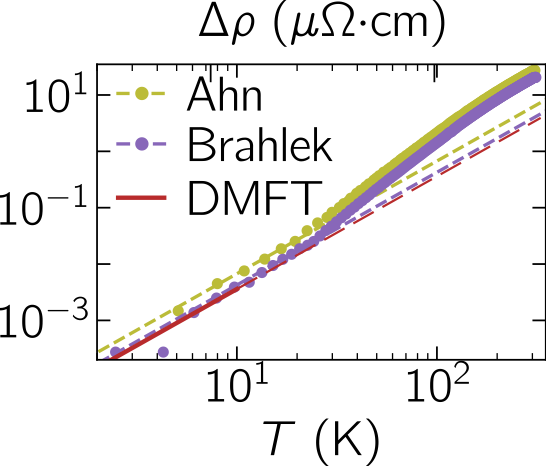
‘When exploring the properties of a material, the resistivity is the quantity that is often first measured, but last understood’, say Barišić et al., PNAS 110, 12235 (2013). Here, we significantly advance our theoretical understanding by computing the DC resistivity of high-conductivity perovskites in the low-energy limit in agreement with measurements on the cleanest samples.
F. B. Kugler, J. Lee-Hand, H. LaBollita, L. Van Muñoz, J. Kaye, S. Beck, A. Hampel, A. Georges, C. E. Dreyer

We show that vacancy-induced impurity states in twisted bilayer graphene (TBG) provide a tunable system to probe the critical destruction of the Kondo effect. We also reveal a dichotomy between vacancies in AA/BB and AB/BA regions, characterized by distinct Kondo temperature distributions stemming from the multifractal nature of magic-angle TBG wavefunctions.
Y. Chang, J. Yi, A.-K. Wu, F. B. Kugler, E. Andrei, D. Vanderbilt, G. Kotliar, J. H. Pixley
Phys. Rev. Lett. 133, 126503 (2024), Editors’ Suggestion

The orbital-selective Mott phase (OSMP), where itinerant and localized electrons coexist, is a fascinating state of matter. But what if we open a new, interorbital hopping channel? We show – with numerical and analytical DMFT arguments – that this destabilizes the OSMP at zero temperature. Hence, the corresponding finite-temperature OSMP stems from a coherent-incoherent crossover instead of a quantum critical point.
F. B. Kugler, G. Kotliar
Phys. Rev. Lett. 129, 096403 (2022)
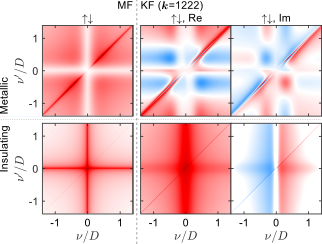
The four-point vertex is a central part of many-body theory – from microscopic Fermi-liquid theory to various vertex corrections to diagrammatic extensions of DMFT. We show how to compute the local four-point vertex with NRG, giving imaginary-frequency vertices at arbitrarily low temperatures and unprecedented non-perturbative real-frequency vertices.
F. B. Kugler, S.-S. B. Lee, J. von Delft
Phys. Rev. X 11, 041006 (2021)
See also Phys. Rev. X 11, 041006 (2021) and Phys. Rev. B 109, 125138 (2024), Editors’ Suggestion.
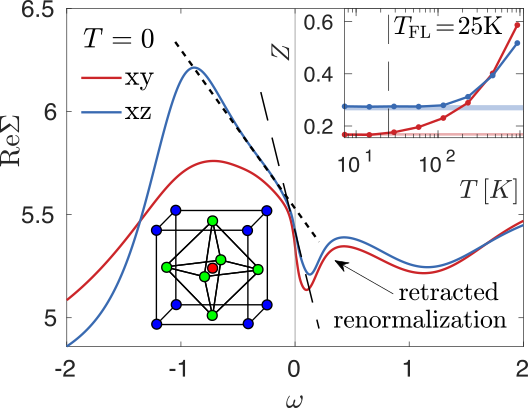
Wouldn’t it be nice to leverage the strengths of NRG (many-body basis of approximate eigenstates, RG flow from isolated impurity to collective state) in the material context? We show that this is indeed possible and characterize the low-energy, Fermi-liquid state of Sr2RuO4 with unprecedented detail and accuracy.
F. B. Kugler, M. Zingl, H. U. R. Strand, S.-S. B. Lee, J. von Delft, A. Georges
Phys. Rev. Lett. 124, 016401 (2020)
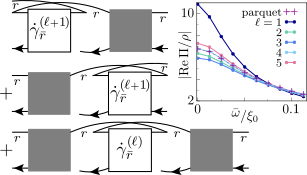
How is solving a truncated functional renormalization group flow connected to solving the parquet equations? We show that both schemes are in fact very closely related and establish their equivalence through a multiloop expansion of the fRG flow equations.
F. B. Kugler, J. von Delft
Phys. Rev. Lett. 120, 057403 (2018)
Full list of publications
ordered by submission date:
-
J. Coulter, F. B. Kugler, H. LaBollita, A. Georges, C. E. Dreyer
Mechanisms for the ultralow room-temperature resistivity of SrMoO3
arXiv:2506.10143
-
J.-M. Lihm, D. Kiese, S.-S. B. Lee, F. B. Kugler
The finite-difference parquet method: Enhanced electron-paramagnon scattering opens a pseudogap
arXiv:2505.20116
-
H. LaBollita, J. Lee-Hand, F. B. Kugler, L. Van Muñoz, J. Kaye, S. Beck, A. Hampel, A. Georges, C. E. Dreyer
Low-temperature transport in high-conductivity correlated metals: a density-functional plus dynamical mean-field study of cubic perovskites
arXiv:2505.04508
-
N. Ritz, A. Ge, M. Frankenbach, M. Pelz, J. von Delft, F. B. Kugler
Testing the parquet equations and the U(1) Ward identity for real-frequency correlation functions from the multipoint numerical renormalization group
arXiv:2504.0591
Phys. Rev. Research 7, 033139 (2025) -
A. Hunter, C. Putzke, F. B. Kugler, S. Beck, E. Cappelli, F. Margot, M. Straub, Y. Alexanian, J. Teyssier, A. de la Torre, K.W. Plumb, M.D. Watson, T.K. Kim, C. Cacho, N.C. Plumb, M. Shi, M. Radovic, J. Osiecki, C. Polley, D.A. Sokolov, A. P. Mackenzie, E. Berg, A. Georges, P. J. W. Moll, A. Tamai, F. Baumberger
Non-Fermi liquid quasiparticles in strain-tuned Sr2RuO4
arXiv:2503.11311
-
D. Oh, A. Hampel, J. P. Wakefield, P. Moen, S. Smit, X. Luo, M. Zonno, S. Gorovikov, M. Leandersson, C. Polley, A. K. Kundu, A. Rajapitamahuni, E. Vescovo, C. Jozwiak, A. Bostwick, E. Rotenberg, M. Isobe, M. Verma, M. Crispino, M. Grundner, F. B. Kugler, O. Parcollet, U. Schollwöck, H. Takagi, A. Damascelli, G. Sangiovanni, J. G. Checkelsky, A. Georges, R. Comin
Hund flat band in a frustrated spinel
arXiv:2502.07234
Proc. Natl. Acad. Sci. U.S.A. 122, e2518213122 (2025) -
F. B. Kugler, J. Lee-Hand, H. LaBollita, L. Van Muñoz, J. Kaye, S. Beck, A. Hampel, A. Georges, C. E. Dreyer
Fermi-liquid T2 resistivity: Dynamical mean-field theory meets experiment
arXiv:2412.16363
-
M. Straub, F. Petocchi, C. Witteveen, F. B. Kugler, A. Hunter, Y. Alexanian, G. Gatti, S. Mandloi, C. Polley, G. Carbone, J. Osiecki, F. O. von Rohr, A. Georges, F. Baumberger, A. Tamai
Nature of metallic and insulating domains in the CDW system 1T-TaSe2
arXiv:2411.18205
Phys. Rev. Lett. 135, 096501 (2025) -
M. Gievers, R. Schmidt, J. von Delft, F. B. Kugler
Subleading logarithmic behavior in the parquet formalism
arXiv:2411.07226
Phys. Rev. B 111, 085151 (2025) -
M. Grundner, F. B. Kugler, O. Parcollet, U. Schollwöck, A. Georges, A. Hampel
LiV2O4: Hund-assisted orbital-selective Mottness
arXiv:2409.17268
Phys. Rev. B 112, L041106 (2025) -
N. Ritz, A. Ge, E. Walter, S. Aguirre, J. von Delft, F. B. Kugler
KeldyshQFT: A C++ codebase for real-frequency multiloop functional renormalization group and parquet computations of the single-impurity Anderson model
arXiv:2405.20996
J. Chem. Phys. 161, 054118 (2024) -
S. Dirnböck, S.-S. B. Lee, F. B. Kugler, S. Huber, J. von Delft, K. Held, M. Wallerberger
Overcomplete intermediate representation of two-particle Green's functions and its relation to partial spectral functions
arXiv:2404.05541
Phys. Rev. Research 6, 043228 (2024) -
M. Grundner, P. Westhoff, F. B. Kugler, O. Parcollet, U. Schollwöck
Complex time evolution in tensor networks
arXiv:2312.11705
Phys. Rev. B 109, 155124 (2024) -
F. B. Kugler, C.-J. Kang, G. Kotliar
Low-energy perspective on two-orbital Hund metals and the case of LaNiO2
arXiv:2312.11457
Phys. Rev. B 110, 155101 (2024) -
Y. Chang, J. Yi, A.-K. Wu, F. B. Kugler, E. Andrei, D. Vanderbilt, G. Kotliar, J. H. Pixley
Vacancy-induced tunable Kondo effect in twisted bilayer graphene
arXiv:2312.09286
Phys. Rev. Lett. 133, 126503 (2024), Editors' Suggestion -
A. Ge, J. Halbinger, S.-S. B. Lee, J. von Delft, F. B. Kugler
Analytic continuation of multipoint correlation functions
arXiv:2311.11389
Ann. Phys. (Berlin) 536, 2300504 (2024) -
J.-M. Lihm, J. Halbinger, J. Shim, J. von Delft, F. B. Kugler, S.-S. B. Lee
Symmetric improved estimators for multipoint vertex functions
arXiv:2310.12098
Phys. Rev. B 109, 125138 (2024), Editors' Suggestion -
A. Ge, N. Ritz, E. Walter, S. Aguirre, J. von Delft, F. B. Kugler
Real-frequency quantum field theory applied to the single-impurity Anderson model
arXiv:2307.10791
Phys. Rev. B 109, 115128 (2024) -
M. K. Ritter, D. Kiese, T. Müller, F. B. Kugler, R. Thomale, S. Trebst, J. von Delft
Benchmark calculations of multiloop pseudofermion fRG
arXiv:2203.13007
Eur. Phys. J. B 95, 102 (2022) -
F. B. Kugler
Improved estimator for numerical renormalization group calculations of the self-energy
arXiv:2202.04063
Phys. Rev. B 105, 245132 (2022), Editors' Suggestion -
M. Gievers, E. Walter, A. Ge, J. von Delft, F. B. Kugler
Multiloop flow equations for single-boson exchange fRG
arXiv:2201.04878
Eur. Phys. J. B 95, 108 (2022) -
F. B. Kugler, G. Kotliar
Is the orbital-selective Mott phase stable against interorbital hopping?
arXiv:2112.14691
Phys. Rev. Lett. 129, 096403 (2022) -
P. Chalupa-Gantner, F. B. Kugler, C. Hille, J. von Delft, S. Andergassen, A. Toschi
Fulfillment of sum rules and Ward identities in the multiloop functional renormalization group solution of the Anderson impurity model
arXiv:2110.07455
Phys. Rev. Research 4, 023050 (2022) -
S.-S. B. Lee, F. B. Kugler, J. von Delft
Computing local multipoint correlators using the numerical renormalization group
arXiv:2101.00708
Phys. Rev. X 11, 041007 (2021) -
F. B. Kugler, S.-S. B. Lee, J. von Delft
Multipoint correlation functions: spectral representation and numerical evaluation
arXiv:2101.00707
Phys. Rev. X 11, 041006 (2021) -
J. Thoenniss, M. K. Ritter, F. B. Kugler, J. von Delft, M. Punk
Multiloop pseudofermion functional renormalization for quantum spin systems: Application to the spin-1/2 kagome Heisenberg model
arXiv:2011.01268
-
C. Hille, F. B. Kugler, C. J. Eckhardt, Y.-Y. He, A. Kauch, C. Honerkamp, A. Toschi, S. Andergassen
Quantitative functional renormalization group description of the two-dimensional Hubbard model
arXiv:2002.02733
Phys. Rev. Research 2, 033372 (2020) -
F. B. Kugler, M. Zingl, H. U. R. Strand, S.-S. B. Lee, J. von Delft, A. Georges
Strongly correlated materials from a numerical renormalization group perspective: How the Fermi-liquid state of Sr2RuO4 emerges
arXiv:1909.02389
Phys. Rev. Lett. 124, 016401 (2020) -
F. B. Kugler, S.-S. B. Lee, A. Weichselbaum, G. Kotliar, J. von Delft
Orbital differentiation in Hund metals
arXiv:1904.10774
Phys. Rev. B 100, 115159 (2019) -
C. J. Lindner, F. B. Kugler, V. Meden, H. Schoeller
Renormalization group transport theory for open quantum systems: Charge fluctuations in multilevel quantum dots in and out of equilibrium
arXiv:1810.12269
Phys. Rev. B 99, 205142 (2019) -
F. B. Kugler
Counting Feynman diagrams via many-body relations
arXiv:1808.01759
Phys. Rev. E 98, 023303 (2018) -
F. B. Kugler, J. von Delft
Derivation of exact flow equations from the self-consistent parquet relations
arXiv:1807.02898
New. J. Phys. 20, 123029 (2018) -
A. Tagliavini, C. Hille, F. B. Kugler, S. Andergassen, A. Toschi, C. Honerkamp
Multiloop functional renormalization group for the two-dimensional Hubbard model: Loop convergence of the response functions
arXiv:1807.02697
SciPost Phys. 6, 009 (2019) -
C. J. Lindner, F. B. Kugler, H. Schoeller, J. von Delft
Flavor fluctuations in 3-level quantum dots: Generic SU(3)-Kondo fixed point in equilibrium and non-Kondo fixed points in nonequilibrium
arXiv:1802.09976
Phys. Rev. B 97, 235450 (2018) -
F. B. Kugler, J. von Delft
Multiloop functional renormalization group for general models
arXiv:1707.04536
Phys. Rev. B 97, 035162 (2018) -
F. B. Kugler, J. von Delft
Fermi-edge singularity and the functional renormalization group
arXiv:1706.06872
J. Phys.: Condens. Matter 30, 195501 (2018) -
F. B. Kugler, J. von Delft
Multiloop functional renormalization group that sums up all parquet diagrams
arXiv:1703.06505
Phys. Rev. Lett. 120, 057403 (2018)